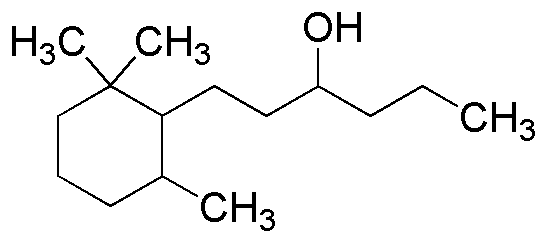1-(2,2,6-Trimethylcyclohexyl)-3-hexanol is widely utilized in research focused on:
- Fragrance Industry: This compound serves as a key ingredient in perfumes and scented products, providing a pleasant aroma and enhancing the overall fragrance profile.
- Cosmetics: It is used in various cosmetic formulations, acting as a skin-conditioning agent that improves texture and moisture retention, making products more appealing to consumers.
- Flavoring Agents: The chemical is incorporated into food and beverage products to impart unique flavors, catering to the growing demand for innovative taste experiences.
- Solvent Applications: It functions as a solvent in industrial processes, aiding in the formulation of paints, coatings, and adhesives, which require effective and safe solvent systems.
- Research and Development: In academic and industrial research, it is used as a reference compound in studies related to organic synthesis and chemical behavior, providing valuable insights into molecular interactions.
General Information
Properties
Safety and Regulations
Applications
1-(2,2,6-Trimethylcyclohexyl)-3-hexanol is widely utilized in research focused on:
- Fragrance Industry: This compound serves as a key ingredient in perfumes and scented products, providing a pleasant aroma and enhancing the overall fragrance profile.
- Cosmetics: It is used in various cosmetic formulations, acting as a skin-conditioning agent that improves texture and moisture retention, making products more appealing to consumers.
- Flavoring Agents: The chemical is incorporated into food and beverage products to impart unique flavors, catering to the growing demand for innovative taste experiences.
- Solvent Applications: It functions as a solvent in industrial processes, aiding in the formulation of paints, coatings, and adhesives, which require effective and safe solvent systems.
- Research and Development: In academic and industrial research, it is used as a reference compound in studies related to organic synthesis and chemical behavior, providing valuable insights into molecular interactions.
Documents
Safety Data Sheets (SDS)
The SDS provides comprehensive safety information on handling, storage, and disposal of the product.
Product Specification (PS)
The PS provides a comprehensive breakdown of the product’s properties, including chemical composition, physical state, purity, and storage requirements. It also details acceptable quality ranges and the product's intended applications.
Certificates of Analysis (COA)
Search for Certificates of Analysis (COA) by entering the products Lot Number. Lot and Batch Numbers can be found on a product’s label following the words ‘Lot’ or ‘Batch’.
*Catalog Number
*Lot Number
Certificates Of Origin (COO)
This COO confirms the country where the product was manufactured, and also details the materials and components used in it and whether it is derived from natural, synthetic, or other specific sources. This certificate may be required for customs, trade, and regulatory compliance.
*Catalog Number
*Lot Number
Safety Data Sheets (SDS)
The SDS provides comprehensive safety information on handling, storage, and disposal of the product.
DownloadProduct Specification (PS)
The PS provides a comprehensive breakdown of the product’s properties, including chemical composition, physical state, purity, and storage requirements. It also details acceptable quality ranges and the product's intended applications.
DownloadCertificates of Analysis (COA)
Search for Certificates of Analysis (COA) by entering the products Lot Number. Lot and Batch Numbers can be found on a product’s label following the words ‘Lot’ or ‘Batch’.
*Catalog Number
*Lot Number
Certificates Of Origin (COO)
This COO confirms the country where the product was manufactured, and also details the materials and components used in it and whether it is derived from natural, synthetic, or other specific sources. This certificate may be required for customs, trade, and regulatory compliance.


